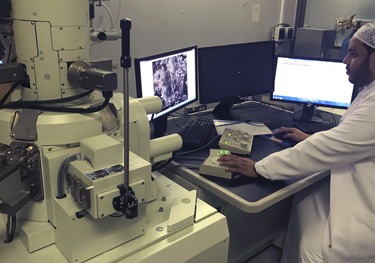
For more than three decades, improvements in computer hardware have been rooted in the top-down miniaturization of transistors in integrated circuitry, leading to a reduction in minimum feature sizes from one micrometer to ten nanometers. However, limitations regarding further reducing the size of integrated circuits have led scientist to consider new solutions to develop future technologies.
One prospective approach that has gained considerable scientific momentum over the past decade is the pursuit of data storage technologies based on individual molecules as memory elements. Towards this end, prior work in our laboratory has focused on exploring the use of switchable, mechanically interlocked molecules (MIMs) as tunnel junctions for data storage media.
We believe that this field can be further advanced by utilizing MIMs incorporated into polymeric materials. A class of nanoporous coordination polymers—namely, metal-organic frameworks (MOFs)—are a form of mechanically robust, crystalline scaffolding for the assembly of switchable MIMs in dense, ordered arrays to resist degradation. Research conducted at the Joint Center of Excellence in Integrated Nanosystems (JCIN) has led to the successful integration of single-station MIMs with MOFs. Moreover, preliminary experiments have confirmed that the resistance of the MIM to oxidative weathering is enhanced upon integration with the MOF, as we had anticipated. Work towards the polyrotaxane has been achieved through the successful synthesis of the necessary monomeric components. These encouraging results have paved the way for our ongoing efforts to synthesize polymeric materials incorporating switchable, two-station MIMs and to validate their performance in prospective data storage media.
This project aims to develop new systems that can alleviate these issues by incorporating MIMs into mechanically robust MOFs. The project objectives are: i) incorporate existing MIMs into MOFs, ii) design and synthesize new switchable MIMs for incorporation into MOFs, iii) evaluate the performance of these systems in prospective data storage media.
Success of this project may accelerate the development of new electronic materials and data storage devices, and will increase investment in technology and the digital economy.
Current advances in computing and circuitry are driven by the miniaturization of components. However, top-down miniaturization, for example using photolithography, is increasingly challenging and cost-prohibitive as transistors enter the nanometer regime. Previous attempts to incorporate memory information into individual, switchable mechanically interlocked molecules have often suffered from a series of technical problems that prevent their commercial development. For example, there are issues with memory elements being irregularly distributed and the architectures employed thus far have often been susceptible to rapid weathering. Another challenge associated with the fabrication of switchable molecular architectures is maintaining or, preferably, increasing storage density while reducing the cell memory size.
In addition to these challenges, the increasing complexity of modern devices, coupled with the desire to make devices more compact whilst retaining much of their ‘smart’ function means that there is a drive to develop more flexible circuitry. Such systems would have a wide-range of uses, including healthcare, wearable and consumer electronics, biometrics and military devices.
One of the ongoing challenges associated with this project is to develop compact, switchable interlocked molecules with limited ranges of motion, which should reduce irregular distributions of memory, but with high levels of conductivity in at
Switchable mechanically interlocked molecules will be synthesized using the wide range of organic supramolecular synthetic techniques developed in the Stoddart group over the preceding three decades. The switchable behavior of these systems can then be evaluated using a variety of techniques. The electronic behavior of these systems can be evaluated electrochemically using cyclic voltammetry, allowing reversible redox (and other) behavior to be observed. Chemical reduction and oxidation can also be combined with a spectroscopic technique such as nuclear magnetic resonance (NMR) and electron paramagnetic resonance (EPR) spectroscopies or UV/Vis spectroscopy, to determine the extent of molecular motion and to determine which constituent parts of the mechanically interlocked molecules interact during these processes.
In collaboration with other research groups at Northwestern University, switchable mechanically interlocked molecules have been successfully incorporated into metal-organic frameworks (MOFs) using solvent-assisted ligand incorporation (SALI) techniques. The successful incorporation of the mechanically interlocked molecule into the metal-organic framework was determined by performing gas adsorption experiments, whereby MIM incorporation resulted in reduced uptake of N2. The average pore widths of the hybrid frameworks were determined using density functional theory calculations and the system was confirmed to still display redox-activity by subjecting them to cyclic voltammetry and UV/Vis spectroscopy.
Flexible electronic systems are being developed by producing a series of flexible organic crystalline materials. Initially, structural motifs which may display promising interactions are evaluated by searching the Cambridge Crystal Structure Database. Those interactions which may lead to desired mechanical properties of crystalline materials (e.g. flexibility) are then selected for subsequent study. Having successfully crystallized a series of targeted compounds, their microstructures were imaged using scanning electron microscopy (SEM) and their flexibility probed by using the same technique, in addition to simple visual observations. Following this, the electronic properties of these materials can be evaluated using piezoresponse force microscopy (PFM).